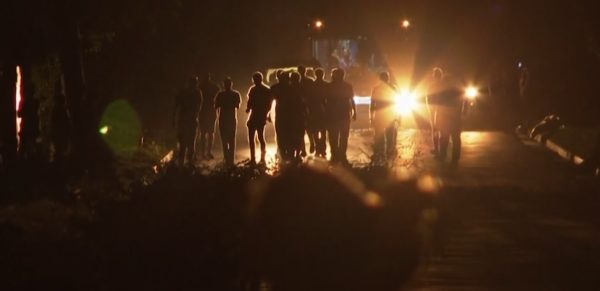Friday Night Protests in Havana, Internet Cut Again

“We consider these claims fair,” declared the president of the Provincial Defense Council on Thursday’s protests
HAVANA TIMES – For the second consecutive day, residents of numerous Havana neighborhoods took to the streets on Friday during the day and into the night. They blocked traffic in several places. In response the regime once again cut off access to Internet to keep people from sharing live what was occurring. On some streets, the protestors made human cordons to close important avenues, as in Cerro.
“In addition to the people holding hands, others have put ropes on the corners of Calzada el Cerro avenue from Tejas to Patria Streets, which involve quite a few blocks,” said a source from the scene.
The protests began in the morning in La Palma and Calzada de Bejucal, in the municipality of Arroyo Naranjo, and then Puentes Grandes, in Playa, where they have not had electricity for 72 hours.
Several videos circulating on social networks before the Internet shutdown show a crowd in Arroyo Naranjo with pots and pans and loudly demanding that the government resolve the energy crisis facing the country. “They blocked the street, so they don’t pass,” says a woman filming the protest. “Down with the dictatorship, enough already!” she shouts, as she joins the protesters. Along with the crowd there are several police without daring to intervene.
Several mothers with their children also went out to protest and prohibited the passage of vehicles in the afternoon on a section of the National Highway known as the First Ring of Havana. Some videos and photos shared on networks recorded the moment when uniformed men are seen trying to convince the protesters to allow passage. They had placed branches and stones blocking the road.
The passage of Hurricane Ian, the collapse of the National Electric System and the growing shortage of supplies have seen groups of Cubans in a new wave of demonstrations in several municipalities of Havana, including Cerro, San Miguel del Padrón and Arroyo Naranjo.
Those who have been able to charge their cell phones and record the protests try not to focus directly on people’s faces, since the Police later use these recordings to identify and arrest them, as happened after the large-scale protests of July 11, 2021.

During the first interruption of the internet on Thursday evening we asked the state service provider, Etecsa, for explanations. The operator’s response was that the service “is interrupted at the national level”, and that work is being done to solve the “difficulty”. Regarding the causes of the interruption, he answered emphatically that “he could not give that information.” With the continued protests on Friday evening another blanket outage has taken place.
On Thursday, some officials of the Provincial Defense Council tried to placate the crowd with the usual government rhetoric. One of these episodes occurred in a Havana neighborhood, where a woman interrupted a leader, dressed as a soldier saying “I don’t believe in you.” Next to her, an older woman snapped at the uniformed woman: “I am materialistic, I am not idealistic, I believe in what I see; if in 72 hours they have not done anything, I have to say that nothing is being done.” The words were welcomed with applause by those present.
Another official, who was trying to “explain the situation”, was also rebuked by those present: “Why don’t they take the fuel from the police patrols and use it for the electric company’s vehicles?”
The president of the Defense Council, Luis Antonio Torres Iríbar, acknowledged on Friday that during the night “we had to face isolated situations in the province, where there were complaints about the water situation, about the electricity situation, about the loss of food due to lack of electricity”. He conceded: “We consider these claims fair”.
“I believe that protesting is a right, but it is a right when those responsible for the State and the Government are failing to do what is their responsibility,” said the official. However, immediately afterwards, he justified: “But under the conditions we are talking about, yesterday’s protests, instead of helping, slow down the fulfillment of that mission and that desire that we have to have a full recovery in the shortest possible time.
Three days after the impact of the hurricane, the lack of electricity mainly affects the little food stored in peoples’ refrigerators. Some managed to freeze some bottles of water to keep the temperature low inside, but by now the ice has already melted, and the food is threatening to spoil.
This has led to the pressing need for people to consume their reserves of meat, milk, and other products. Even if electricity is restored in the coming hours, getting food will be the toughest challenge for the population in a country that, before the hurricane, already had alarming shortages.
Meanwhile, the Government has mobilized its police and military forces, which has left several points that the authorities consider key “unprotected”, such as the ration stores. In these establishments, as well as in warehouses or other food storage facilities, the Police have placed inconspicuous “collaborators”, often young men of military age, to stand guard.
According to the official newspaper Tribuna de La Habana, the Ministry of Internal Trade reported that more than 700 “economic objectives” were damaged by Hurricane Ian in the west of the island, which includes government ration stores, restaurants, warehouses, and construction material stores. Landslides, fallen roofs and the disabling of structures are some of the most serious damages, along with the loss of products.
The Government has assured that it prioritizes “maintaining offers of prepared food for the evacuated population”, which are limited in their ability to cook. It forgets, however, that the rest of the country faces those same limitations to preserve and cook products without electricity.





